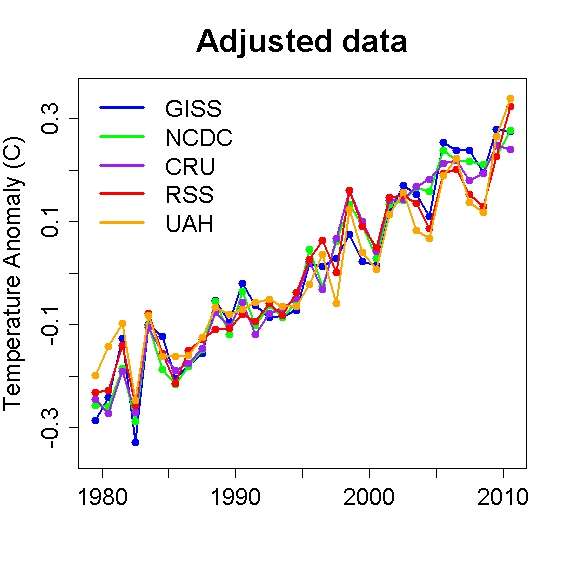Three decades of global cooling was the bold prediction made by geology professor Don Easterbrook on Anthony Watt's Weblog award winning climate change denier web site. Unlike most of the posts on Watt's site, Prof. Easterbrook's article had an element of sound science to it. If greenhouse gases had little or no effect on global temperatures, the cooling shift in ocean currents and weather patterns in the north Pacific Ocean would cause about 3 decades of global cooling. El Nino events, where warm water surges across the equator towards the Americas in the Pacific, are known to warm the earth for about a year. La Nina events, where more cold water than normal upwells in the equatorial Pacific, are known to cause a year or two of cooling. The cool phase of the "Pacific Decadal Oscillation" has more La Ninas and fewer El Ninos than the warm phase. The shift to the cool phase of the PDO would cause cooling if all other variables were held constant.
Oscillation from its warm mode to cool mode assures global cooling for the next three decades.
Don J. Easterbrook, Dept. of Geology, Western Washington University, Bellingham, WA
Addressing the Washington Policymakers in Seattle, WA, Dr. Don Easterbrook said that shifting of the Pacific Decadal Oscillation (PDO) from its warm mode to its cool mode virtually assures global cooling for the next 25-30 years and means that the global warming of the past 30 years is over. The announcement by NASA that the (PDO) had shifted from its warm mode to its cool mode (Fig. 1) is right on schedule as predicted by past climate and PDO changes (Easterbrook, 2001, 2006, 2007) and is not an oddity superimposed upon and masking the predicted severe warming by the IPCC. This has significant implications for the future and indicates that the IPCC climate models were wrong in their prediction of global temperatures soaring 1°F per decade for the rest of the century.
NASA Identifies Shift in Pacific Decadal Oscillation (PDO) from warm to cool
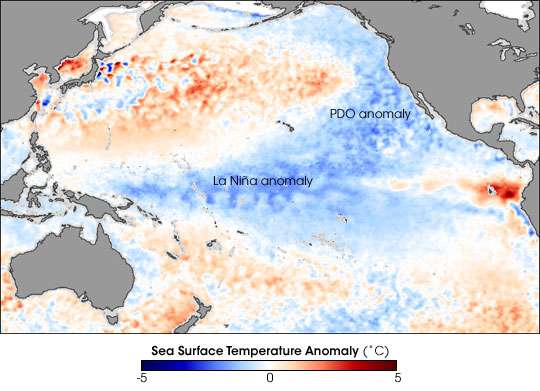
Image: NASA: La Nina and Pacific Decadal Oscillation Cool the Pacific,
April 29, 2008
Professor Easterbrook made a bold prediction, based on copying a former cool period, of 30 years of cooler than normal temperatures in the equatorial Pacific.
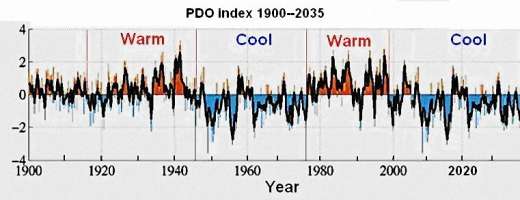
Three years into the global cooling forecast, how's it working out?
The forecast of the PDO shift to the cool phase appears to be verifying. However, the earth does not appear to be cooling as forecast. The Pacific has had a strong La Nina event in 2010 continuing into 2011, but the World Meteorological Organization found it was the warmest La Nina in the climate record and warned, “Our science is solid and it proves unequivocally that the world is warming and that this warming is due to human activities. Concentrations of greenhouse gases in the atmosphere have reached new highs. They are very rapidly approaching levels consistent with a 2-2.4 degree Centigrade rise in average global temperatures which scientists believe could trigger far reaching and irreversible changes in our Earth, biosphere and oceans.”
Global climate in 2011 was heavily influenced by the strong La Niña event which developed in the tropical Pacific in the second half of 2010 and continued until May 2011. It was one of the strongest of the last 60 years and was closely associated with the drought in east Africa, islands in the central equatorial Pacific and the southern United States, and flooding in southern Africa, eastern Australia and southern Asia.Strong La Niña years are typically 0.10 to 0.15°C cooler than the years preceding and following them. 2011’s global temperatures followed this pattern, being lower than those of 2010, but were still considerably warmer than the most recent moderate to strong La Niña years, 2008 (+0.36°C), 2000 (+0.27°C) and 1989 (+0.12°C).
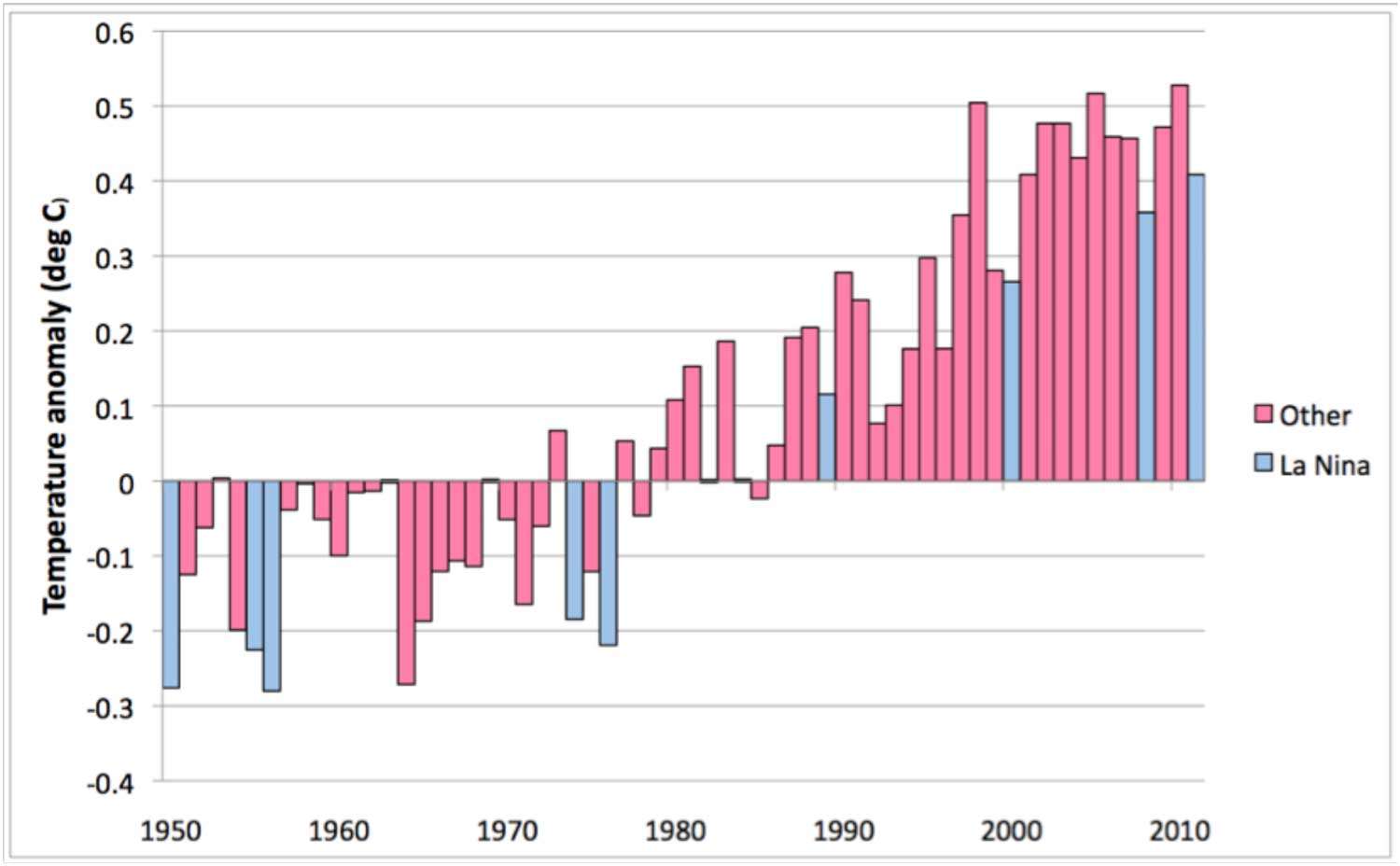
The 5 raw data sets of land and satellite based global temperature measurements have a high degree of short term variability. El Nino and La Nina events, solar cycles and volcanic eruptions are major contributors to short term variability.
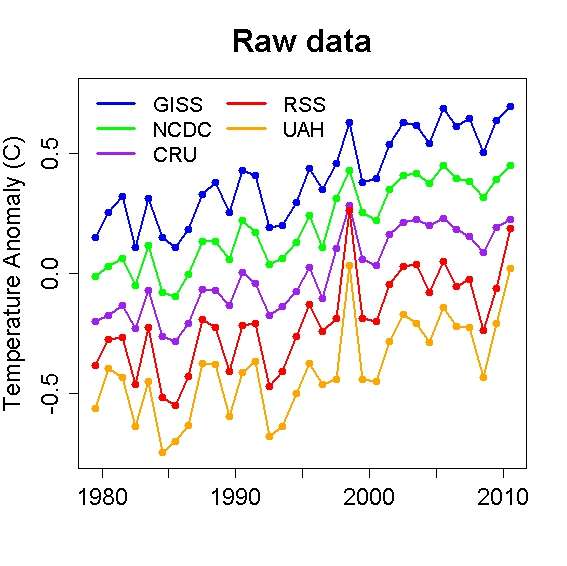
El Nino and La Nina events caused most of the short-term variability. Two volcanic eruptions put reflective aerosols into the stratosphere causing 2 strong cooling events. And the deep solar minimum in 2009 added to recent cooling by La Nina.
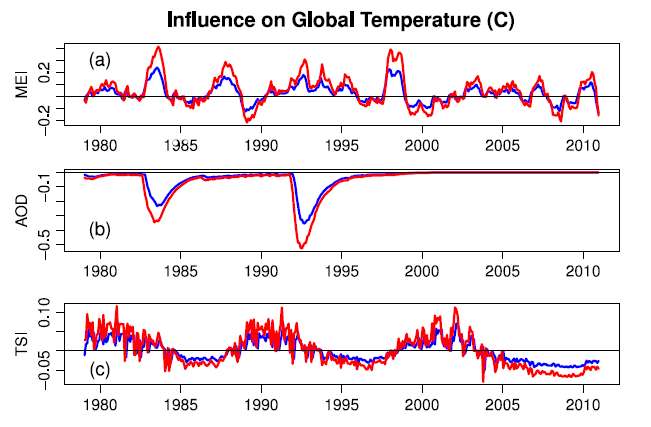 Figure 7. Influence of exogenous factors on global temperature for GISS (blue) and RSS data (red). (a) MEI; (b) AOD; (c) TSI MEI is the Multivariate El Nino index, AOD is the Aerosol Optical Depth (volcanic), and TSI is the Total Solar Irradiance.
Figure 7. Influence of exogenous factors on global temperature for GISS (blue) and RSS data (red). (a) MEI; (b) AOD; (c) TSI MEI is the Multivariate El Nino index, AOD is the Aerosol Optical Depth (volcanic), and TSI is the Total Solar Irradiance.
When these 3 major factors causing short term variability are adjusted for the warming signal becomes much clearer in each of the 5 data sets. The minor differences between satellite and surface based data are inconsequential. Measurement methods do not appear to affect the trends in any way.
The True Global Warming Signal
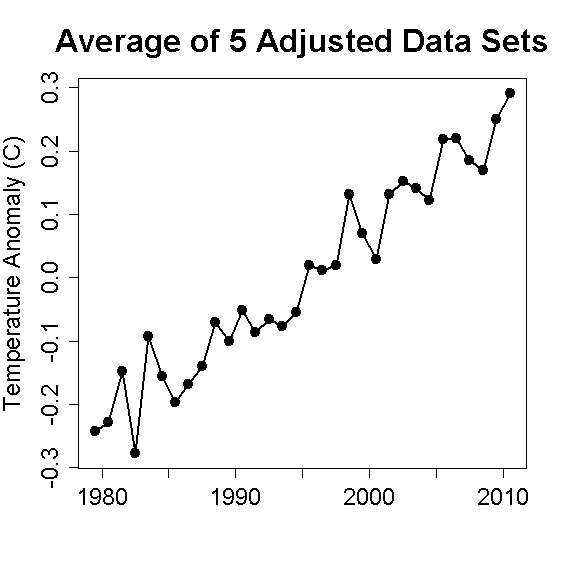
The resultant adjusted data show clearly, both visually and when subjected to statistical analysis, that the rate of global warming due to other factors (most likely these are exclusively anthropogenic) has been remarkably steady during the 32 years from 1979 through 2010.There is no indication of any slowdown or acceleration of global warming, beyond the variability induced by these known natural factors. Because the effects of volcanic eruptions and of ENSO are very short-term and that of solar variability very small (figure 7), none of these factors can be expected to exert a significant influence on the continuation of global warming over the coming decades. The close agreement between all five adjusted data sets suggests that it is meaningful to average them in order to produce a composite record of planetary warming. Annual averages of the result are shown in figure 8.
This is the true global warming signal.
Quite simply, the climate change claims of Watts, Fox News and Rupert Murdoch's media empire are crap.
Despite the utter lack of truth to the deniers cliams, Murdoch, the Kochs and the fossil fuel industry have bullied every Republican presidential candidate on their knees.
And they are holding American and the world hostage on fighting the climate crisis.
There's only one way to deal with bullies and hostage takers. Stand up to them. Australia legislated a tax on carbon emissions because their green party stood up to Rupert Murdoch's media empire. Senator Christine Milne, Deputy Leader of Australia’s Green Party, showed how to beat the Murdoch media empire by standing up and never backing down.
“We fought back. It was a totally committed strategy,” Milne told Climate Progress. “This is about saving the planet’s climate. That is what we are here for. This is why you need real leadership and not just a response to the populist views echoed from the vested, self interests.”
http://www.youtube.com/...“Australia has been heavily influenced by some of the major think tanks in the United States that are funded by Big Tobacco, Big Oil, Big Fossil Fuels interests. We’ve already seen the American Legislative Exchange Council and the Heartland Foundation [Institute] supporting Australian politicians going over to the United States and picking up those tactics to the point where one Australian politician was exposed recently for fake websites, a tactic straight out of those kind of foundations.”
“We have seen a heavily funded negative campaign being directed straight into Australia, straight into conservative think tanks and onto the front pages of the Murdoch press.”
“The Murdoch press is a very big problem in Australia. It owns 70% of the print media and has run a massive campaign against the climate science and against the climate pricing policy that we’ve delivered in Australia. And it will continue to do so in the hope that the opposition is elected and the whole thing is repealed. This is a critical time in Australian politics and for the climate.”
Milne lamented the bullying of climate scientists in Australia, many of whom were moved into different facilities after receiving death threats and threats against their families. “It is shocking, and we need to stand up to it,” she said.
We must stand up to it. In 2011 the United States has broken the record for billion dollar (inflation adjusted) weather disasters with 12 disasters by the beginning of December. Globally, the weather has been catastrophic. La Ninas in a warming climate bring excessive rain to areas where the strong trade winds import the excessive amounts of moisture taken from warming oceans. And other areas, like Texas, suffer record breaking droughts.
We must stand up to the climate change deniers. As the climate warms, climate models predict more extreme weather will occur more frequently. That's what happened in 2011. And the future will see even more disasters with greater consequences if we don't act now.
